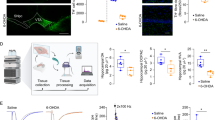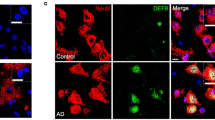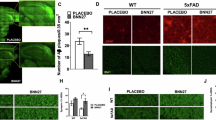Abstract
Synaptic loss in the brain correlates well with disease severity in Alzheimer disease (AD). Deficits in brain-derived neurotrophic factor/tropomyosin-receptor-kinase B (TrkB) signaling contribute to the synaptic dysfunction of AD. We have recently identified 7,8-dihydroxyflavone (7,8-DHF) as a potent TrkB agonist that displays therapeutic efficacy toward various neurological diseases. Here we tested the effect of 7,8-DHF on synaptic function in an AD model both in vitro and in vivo. 7,8-DHF protected primary neurons from Aβ-induced toxicity and promoted dendrite branching and synaptogenesis. Chronic oral administration of 7,8-DHF activated TrkB signaling and prevented Aβ deposition in transgenic mice that coexpress five familial Alzheimer’s disease mutations (5XFAD mice). Moreover, 7,8-DHF inhibited the loss of hippocampal synapses, restored synapse number and synaptic plasticity, and prevented memory deficits. These results suggest that 7,8-DHF represents a novel oral bioactive therapeutic agent for treating AD.
Similar content being viewed by others
Log in or create a free account to read this content
Gain free access to this article, as well as selected content from this journal and more on nature.com
or
References
Andero R, Daviu N, Escorihuela RM, Nadal R, Armario A (2012). 7,8-dihydroxyflavone, a TrkB receptor agonist, blocks long-term spatial memory impairment caused by immobilization stress in rats. Hippocampus 22: 399–408.
Andero R, Heldt SA, Ye K, Liu X, Armario A, Ressler KJ (2011). Effect of 7,8-dihydroxyflavone, a small-molecule TrkB agonist, on emotional learning. Am J Psychiatry 168: 163–172.
Apawu AK, Maina FK, Taylor JR, Mathews TA (2013). Probing the ability of presynaptic tyrosine kinase receptors to regulate striatal dopamine dynamics. ACS Chem Neurosci 4: 895–904.
Arancibia S, Silhol M, Mouliere F, Meffre J, Hollinger I, Maurice T et al (2008). Protective effect of BDNF against beta-amyloid induced neurotoxicity in vitro and in vivo in rats. Neurobiol Dis 31: 316–326.
Bachmanov AA, Reed DR, Beauchamp GK, Tordoff MG (2002). Food intake, water intake, and drinking spout side preference of 28 mouse strains. Behav Genet 32: 435–443.
Beck M, Flachenecker P, Magnus T, Giess R, Reiners K, Toyka KV et al (2005). Autonomic dysfunction in ALS: a preliminary study on the effects of intrathecal BDNF. Amyotroph Lateral Scler Other Motor Neuron Disord 6: 100–103.
Bekinschtein P, Cammarota M, Katche C, Slipczuk L, Rossato JI, Goldin A et al (2008). BDNF is essential to promote persistence of long-term memory storage. Proc Natl Acad Sci USA 105: 2711–2716.
Berg L, McKeel DW Jr, Miller JP, Storandt M, Rubin EH, Morris JC et al (1998). Clinicopathologic studies in cognitively healthy aging and Alzheimer's disease: relation of histologic markers to dementia severity, age, sex, and apolipoprotein E genotype. Arch Neurol 55: 326–335.
Chalermpalanupap T, Kinkead B, Hu WT, Kummer MP, Hammerschmidt T, Heneka MT et al (2013). Targeting norepinephrine in mild cognitive impairment and Alzheimer's disease. Alzheimers Res Ther 5: 21.
Chan CB, Liu X, Pradoldej S, Hao C, An J, Yepes M et al (2011). Phosphoinositide 3-kinase enhancer regulates neuronal dendritogenesis and survival in neocortex. J Neurosci 31: 8083–8092.
Chapman PF, White GL, Jones MW, Cooper-Blacketer D, Marshall VJ, Irizarry M et al (1999). Impaired synaptic plasticity and learning in aged amyloid precursor protein transgenic mice. Nat Neurosci 2: 271–276.
Choi DC, Maguschak KA, Ye K, Jang SW, Myers KM, Ressler KJ (2010). Prelimbic cortical BDNF is required for memory of learned fear but not extinction or innate fear. Proc Natl Acad Sci USA 107: 2675–2680.
Coleman P, Federoff H, Kurlan R (2004). A focus on the synapse for neuroprotection in Alzheimer disease and other dementias. Neurology 63: 1155–1162.
Devi L, Ohno M (2012). 7,8-dihydroxyflavone, a small-molecule TrkB agonist, reverses memory deficits and BACE1 elevation in a mouse model of Alzheimer's disease. Neuropsychopharmacology 37: 434–444.
Diniz BS, Teixeira AL (2011). Brain-derived neurotrophic factor and Alzheimer's disease: physiopathology and beyond. Neuromolecular Med 13: 217–222.
Gomes RA, Hampton C, El-Sabeawy F, Sabo SL, McAllister AK (2006). The dynamic distribution of TrkB receptors before, during, and after synapse formation between cortical neurons. J Neurosci 26: 11487–11500.
Gupta VK, You Y, Li JC, Klistorner A, Graham SL (2013). Protective effects of 7,8-dihydroxyflavone on retinal ganglion and RGC-5 cells against excitotoxic and oxidative stress. J Mol Neurosci 49: 96–104.
Heneka MT, Kummer MP, Stutz A, Delekate A, Schwartz S, Vieira-Saecker A et al (2013). NLRP3 is activated in Alzheimer's disease and contributes to pathology in APP/PS1 mice. Nature 493: 674–678.
Hiester BG, Galati DF, Salinas PC, Jones KR (2013). Neurotrophin and Wnt signaling cooperatively regulate dendritic spine formation. Mol Cell Neurosci 56C: 115–127.
Hong Y, Chan CB, Kwon IS, Li X, Song M, Lee HP et al (2012). SRPK2 phosphorylates tau and mediates the cognitive defects in Alzheimer's disease. J Neurosci 32: 17262–17272.
Hongpaisan J, Sun MK, Alkon DL (2011). PKC epsilon activation prevents synaptic loss, Abeta elevation, and cognitive deficits in Alzheimer's disease transgenic mice. J Neurosci 31: 630–643.
Jang SW, Liu X, Yepes M, Shepherd KR, Miller GW, Liu Y et al (2010). A selective TrkB agonist with potent neurotrophic activities by 7,8-dihydroxyflavone. Proc Natl Acad Sci USA 107: 2687–2692.
Josephs KA, Whitwell JL, Ahmed Z, Shiung MM, Weigand SD, Knopman DS et al (2008). Beta-amyloid burden is not associated with rates of brain atrophy. Ann Neurol 63: 204–212.
Kimura R, Ohno M (2009). Impairments in remote memory stabilization precede hippocampal synaptic and cognitive failures in 5XFAD Alzheimer mouse model. Neurobiol Dis 33: 229–235.
Liu X, Chan CB, Jang SW, Pradoldej S, Huang J, He K et al (2010). A Synthetic 7,8-dihydroxyflavone derivative promotes neurogenesis and exhibits potent antidepressant effect. J Med Chem 53: 8274–8286.
Liu X, Qi Q, Xiao G, Li J, Luo HR, Ye K (2013). O-methylated metabolite of 7,8-dihydroxyflavone activates TrkB receptor and displays antidepressant activity. Pharmacology 91: 185–200.
Lu B, Nagappan G, Guan X, Nathan PJ, Wren P (2013). BDNF-based synaptic repair as a disease-modifying strategy for neurodegenerative diseases. Nat Rev Neurosci 14: 401–416.
Mantilla CB, Ermilov LG (2012). The novel TrkB receptor agonist 7,8-dihydroxyflavone enhances neuromuscular transmission. Muscle Nerve 45: 274–276.
Matthews KL, Chen CP, Esiri MM, Keene J, Minger SL, Francis PT (2002). Noradrenergic changes, aggressive behavior, and cognition in patients with dementia. Biol Psychiatry 51: 407–416.
Murer MG, Boissiere F, Yan Q, Hunot S, Villares J, Faucheux B et al (1999). An immunohistochemical study of the distribution of brain-derived neurotrophic factor in the adult human brain, with particular reference to Alzheimer's disease. Neuroscience 88: 1015–1032.
Murer MG, Yan Q, Raisman-Vozari R (2001). Brain-derived neurotrophic factor in the control human brain, and in Alzheimer's disease and Parkinson's disease. Prog Neurobiol 63: 71–124.
Nagahara AH, Merrill DA, Coppola G, Tsukada S, Schroeder BE, Shaked GM et al (2009). Neuroprotective effects of brain-derived neurotrophic factor in rodent and primate models of Alzheimer's disease. Nat Med 15: 331–337.
Narisawa-Saito M, Wakabayashi K, Tsuji S, Takahashi H, Nawa H (1996). Regional specificity of alterations in NGF, BDNF and NT-3 levels in Alzheimer's disease. Neuroreport 7: 2925–2928.
Oakley H, Cole SL, Logan S, Maus E, Shao P, Craft J et al (2006). Intraneuronal beta-amyloid aggregates, neurodegeneration, and neuron loss in transgenic mice with five familial Alzheimer's disease mutations: potential factors in amyloid plaque formation. J Neurosci 26: 10129–10140.
Ochs G, Penn RD, York M, Giess R, Beck M, Tonn J et al (2000). A phase I/II trial of recombinant methionyl human brain derived neurotrophic factor administered by intrathecal infusion to patients with amyotrophic lateral sclerosis. Amyotroph Lateral Scler Other Motor Neuron Disord 1: 201–206.
Oddo S, Caccamo A, Shepherd JD, Murphy MP, Golde TE, Kayed R et al (2003). Triple-transgenic model of Alzheimer's disease with plaques and tangles: intracellular Abeta and synaptic dysfunction. Neuron 39: 409–421.
Phillips HS, Hains JM, Armanini M, Laramee GR, Johnson SA, Winslow JW (1991). BDNF mRNA is decreased in the hippocampus of individuals with Alzheimer's disease. Neuron 7: 695–702.
Sato M, Murakami K, Uno M, Nakagawa Y, Katayama S, Akagi KI et al (2013). Site-specific inhibitory mechanism for amyloid-beta42 aggregation by catechol-type flavonoids targeting the Lys residues. J Biol Chem 188: 23212–23224.
Scheff SW, Price DA, Schmitt FA, Scheff MA, Mufson EJ (2011). Synaptic loss in the inferior temporal gyrus in mild cognitive impairment and Alzheimer's disease. J Alzheimers Dis 24: 547–557.
Selkoe DJ (2002). Alzheimer's disease is a synaptic failure. Science 298: 789–791.
Sze CI, Troncoso JC, Kawas C, Mouton P, Price DL, Martin LJ (1997). Loss of the presynaptic vesicle protein synaptophysin in hippocampus correlates with cognitive decline in Alzheimer disease. J Neuropathol Exp Neurol 56: 933–944.
Terry RD, Masliah E, Salmon DP, Butters N, DeTeresa R, Hill R et al (1991). Physical basis of cognitive alterations in Alzheimer's disease: synapse loss is the major correlate of cognitive impairment. Ann Neurol 30: 572–580.
Weinshenker D (2008). Functional consequences of locus coeruleus degeneration in Alzheimer's disease. Curr Alzheimer Res 5: 342–345.
Zeng Y, Lv F, Li L, Yu H, Dong M, Fu Q (2012). 7,8-dihydroxyflavone rescues spatial memory and synaptic plasticity in cognitively impaired aged rats. J Neurochem 122: 800–811.
Zeng Y, Tan M, Kohyama J, Sneddon M, Watson JB, Sun YE et al (2011). Epigenetic enhancement of BDNF signaling rescues synaptic plasticity in aging. J Neurosci 31: 17800–17810.
Zhang XM, Cai Y, Xiong K, Cai H, Luo XG, Feng JC et al (2009). Beta-secretase-1 elevation in transgenic mouse models of Alzheimer's disease is associated with synaptic/axonal pathology and amyloidogenesis: implications for neuritic plaque development. Eur J Neurosci 30: 2271–2283.
Zuccato C, Cattaneo E (2009). Brain-derived neurotrophic factor in neurodegenerative diseases. Nat Rev Neurol 5: 311–322.
Acknowledgements
This work was supported by a grant from the National Institute of Health (RO1, DC010204) to K Ye, the NIH/NIAP50 ADRC center grant to both K Ye and D Weinshenker, and a grant from the National Natural Science Foundation of China (No. 81100958) to Z Zhang.
Author information
Authors and Affiliations
Corresponding author
Rights and permissions
About this article
Cite this article
Zhang, Z., Liu, X., Schroeder, J. et al. 7,8-Dihydroxyflavone Prevents Synaptic Loss and Memory Deficits in a Mouse Model of Alzheimer’s Disease. Neuropsychopharmacol 39, 638–650 (2014). https://doi.org/10.1038/npp.2013.243
Received:
Revised:
Accepted:
Published:
Issue date:
DOI: https://doi.org/10.1038/npp.2013.243
Keywords
This article is cited by
-
FSH and ApoE4 contribute to Alzheimer’s disease-like pathogenesis via C/EBPβ/δ-secretase in female mice
Nature Communications (2023)
-
Early 7,8-Dihydroxyflavone Administration Ameliorates Synaptic and Behavioral Deficits in the Young FXS Animal Model by Acting on BDNF-TrkB Pathway
Molecular Neurobiology (2023)
-
A TrkB agonist prodrug prevents bone loss via inhibiting asparagine endopeptidase and increasing osteoprotegerin
Nature Communications (2022)
-
Treating Parkinson's Disease via Activation of BDNF/TrkB Signaling Pathways and Inhibition of Delta-Secretase
Neurotherapeutics (2022)
-
Modulating the Gut Microbiota as a Therapeutic Intervention for Alzheimer’s Disease
Indian Journal of Microbiology (2022)



